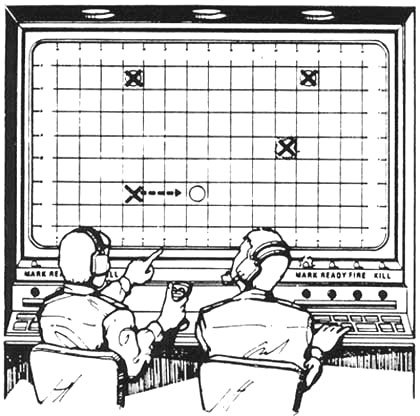
SOVIET COMMAND AND CONTROL CONCEPT
SLIDE 66

On this slide we show a postulated Soviet fire control system
for the grid weapon. .
Two or more operators sit at a control console, facing a giant display (screen). The display contains a grid which represents the distant interference grid of the
Woodpecker carriers (or scalar EM carriers, if in the underground or underwater mode). A distant missile launched into the real interference grid overhead will cause
a spot of light to appear in the appropriate grid square (cell) on the operators’ screen. The operators will track the displayed
target, select firing mode and type of action, engage the target, and assess whether or not the distant target is killed or missed by the firing.
When a missile is launched in the distant area over which the Woodpecker grid has been placed, it quickly rises through one of the scanned grid cells on its upward journey. As it penetrates the cell, additional energy is extracted (since part of the missile’s exhaust energy is now extracted also). At the screen in the Soviet Union,
the additional energy received rises above bias, causing a "bloom" or spot of
light to appear on the screen at the appropriate grid cell representation.
The distant operator has now
detected the missile launch and its location. He places a marker over the target
track and activates the computer, also inputting the type of firing or action to
be performed. In this case, let us say he wishes a burst of energy to emerge inside
the distant launched missile, and has activated that mode of firing action.
The computer computes the
necessary parameters for another scalar interferometer channel in the exothermic
mode, and for firing at the location of the rising missile so that two scalar pulses will
meet in the cell
penetrated by the rising missile on the other side of the earth. As the channel
is opened, the firing solution settled, and the
interferometer howitzer readied, the computer activates indicators on the
console notifying the operator. When all is ready, a "ready-to-fire"
light is lit on the console.
Upon receiving the command to fire
and destroy the missile, the operator presses the fire button. The computer
fires the activated scalar EM howitzer ;n the pulse mode. The operator continues
to watch his screen.
When the pulses meet in the
distant grid cell, a violent EMP suddenly arises in and throughout the missile and its
surrounding vicinity. This explodes the missile propellants and
warheads, destroying the target..
On the distant screen, a sudden
drastic "blossoming" of the target results from the sudden extraction
of a great deal of additional energy by the scanning scalar interferometer. The operator thus knows he has made a "kill."
Should for some reason the
target be missed, additional energy will still be extracted by the scanning
interferometer from the grid cell/vicinity in which the EMP suddenly emerges.
The distant operator will still see a bloom on his scope, but not nearly so great as when
the missile explodes. He thus knows that the EMP effect of the firing has
occurred, but the target has been missed (he will see the bloom in its offset
location as well) .In that case, the operator can quickly mark the EMP location,
hit the switch, and the computer
will automatically correct and fire again.
At any rate, for a miss a large
"sonic boom" or blast still results in the EMP emergence zone from
sudden heating of the air. These are precisely the type of booms that were
associated with three NASA shuttle launches prior to the end of 1985. These
were actual testing of this weapon system, using the shuttle launches to provide
a target, and delaying the burst some minutes so the shuttle would not actually be destroyed. On
Nov. 26, 1985 a "marker beacon" (glowing
ball of light) was also created over the site. This was probably to orient satellites
and other detection systems. Some 12 minutes after that nighttime launch, a large blast occurred over the
site, heard for hundreds of miles up and
down the coast. Shortly after, the light suddenly moved away very rapidly --
faster than a jet aircraft.
If many missiles are being
launched, the operator marks them rapidly, one after the other, and the howitzer
fires burst after burst at them, decimating the launched missiles, one after the other. In this
fashion most of the counterstrike missiles launched by the U.S. would be destroyed shortly after launch, greatly
reducing the number of missiles which make it to midcourse.
However, apparently the loss of
the shuttle launched on Jan. 28, 1986 was caused by the addition of a
metal-softening pattern in the exothermic mode, in and around the booster, using
the actual booster ionic flames as a receiver-amplifier. This led to the failure
of one of the supports and the partial breakaway of the right booster. The
booster rotated into the tank, causing damage and the resulting explosion when
the venting main fuel hit the booster flame.
By spread spectrum techniques
and proper timing and phasing, one system of Woodpecker transmitters can set up
multiple interference grids, in various parts of the world. The scanners and
howitzers can operate in the appropriate zones, again by spread spectrum
techniques and proper timing and phasing.
In fact, the latest versions
probably can operate in the "ordinary EM carrier" (atmospheric) mode
and the "scalar EM carrier" (underwater and in the earth) mode
simultaneously -- again by timed switching between EM and scalar EM carriers,
spread spectrum techniques, and timing and phasing of howitzers and scanners.
Thus a single system can operate
in the earth, underwater, and atmospheric modes. It can operate against the very
wide range of different targets previously mentioned. It can do all this
"simultaneously," from a real-time practical viewpoint.